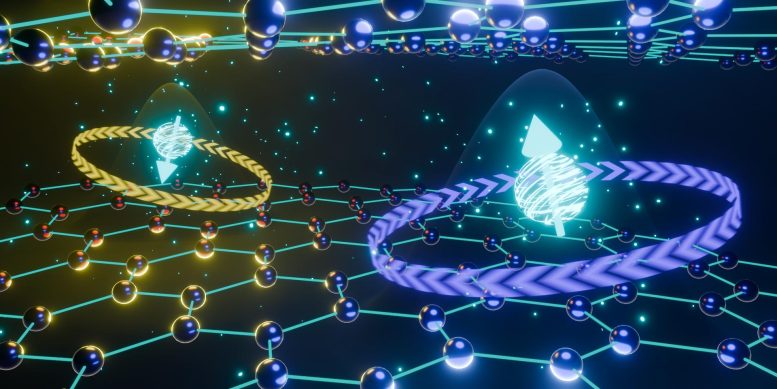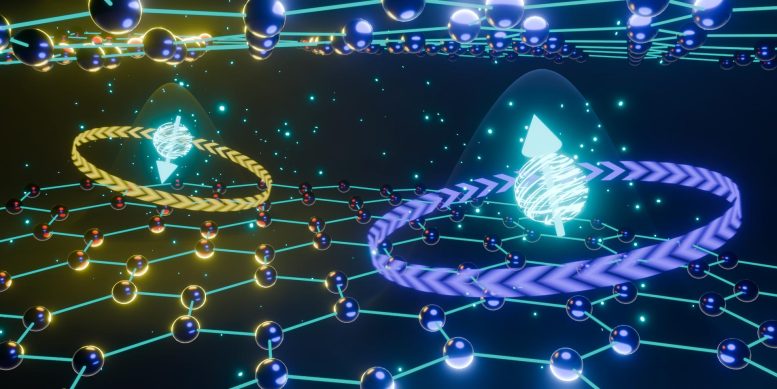

In the BLG double quantum dot used in this work, electrons (the blue spheres) have both an intrinsic angular momentum (spin, given by the arrows through the spheres) and a pseudo-spin (valley, given by the rings rotating in opposite directions). Credit: ETH Zurich/Chuyao Tong
Researchers in the Laboratory for Solid State Physics at ETH Zurich found evidence that bilayer graphene quantum dots may host a promising new type of quantum bit based on so-called valley states.
In quantum computing, the question as to what physical system, and which degrees of freedom within that system, may be used to encode quantum bits of information – qubits, in short – is at the heart of many research projects carried out in physics and engineering laboratories. Superconducting qubits, spin qubits, and qubits encoded in the motion of trapped ions are already recognized widely as prime candidates for future practical applications of quantum computers; other systems need to be better understood and thus offer a stimulating ground for fundamental investigation.
Dr. Rebekka Garreis, Dr. Chuyao Tong, Dr. Wister Huang and their colleagues in the group of Professors Klaus Ensslin and Thomas Ihn from the Department of Physics at ETH Zurich have been looking into bilayer graphene (BLG) quantum dots, known as a potential platform for spin qubits, to find out if another degree of freedom of BLG can be used to encode quantum information.
Their latest findings, just published on January 17 in Nature Physics with collaborators from the National Institute for Materials Science in Japan, show that the so-called valley degree of freedom in BLG is associated with quantum states that are extremely long-lived and are thus worth considering further as an additional resource for solid-state quantum computing.
The Strength of Graphene Layers
Graphene is a two-dimensional material given by a single layer of carbon atoms bound in a hexagonal lattice structure. Its sheet-like appearance is deceitful, as graphene is among the strongest materials on Earth; its mechanical and electronic properties are of great interest to many industry sectors. In bilayer graphene, the system used by the researchers, two sheets of carbon atoms lie on top of each other.
Both graphene and BLG are semimetals, as they lack the characteristic energy band gap found in semiconductors and, most notably, insulators. Nevertheless, a tunable band gap can be engineered in BLG by applying an electric field perpendicularly to the plane of the sheets.
Opening a band gap is necessary to use BLG as a host material for quantum dots, which are nanometer-scale ‘boxes’ capable of confining single or few electrons. Usually fabricated in semiconductor host materials, quantum dots offer excellent control over individual electrons. For this reason, they are an important platform for spin qubits, systems where quantum information is encoded in the electron spin degree of freedom.
Because quantum information is much more prone to being corrupted – and therefore become unsuitable for computational tasks – by the surrounding environment than its classical counterpart, researchers who study different qubit candidates must characterize their coherence properties: these tell them how well and for how long quantum information can survive in their qubit system.
In most traditional quantum dots, electron spin decoherence can be caused by the spin-orbit interaction, which introduces an unwanted coupling between the electron spin and the vibrations of the host lattice, and the hyperfine interaction between the electron spin and the surrounding nuclear spins.
In graphene as well as in other carbon-based materials, spin-orbit coupling and hyperfine interaction are both weak: this makes graphene quantum dots especially appealing for spin qubits. The results reported by Garreis, Tong, and co-authors add one more promising facet to the picture.
Valley States: A New Frontier in Quantum Computing
The hexagonal lattice of BLG can be imaged with specific microscopy techniques. The hexagonal symmetry observed in this so-called real space is also present in momentum space, where the vertices of the lattice don’t correspond to the spatial locations of carbon atoms but to values of momentum associated with the free electrons on the lattice.
In momentum space, free electrons are found in the local minima and maxima of the energy landscape, namely at points where the conduction and valence bands meet. These energy extrema are called valleys.
In BLG, the hexagonal symmetry dictates the existence of two degenerate energy valleys (that is, characterized by the same electron energy) corresponding to opposite electron momentum values. This valley degree of freedom can be treated in much the same way as electron spin in BLG – in fact, valleys in graphene are commonly called pseudo-spins. While valley states in bilayer graphene were known before, their suitability as practical qubits remained unclear until now.
Garreis, Tong, and co-workers considered a double quantum dot – that is, two dots with tunable coupling – in BLG and measured the relaxation time for valley and spin states. The relaxation time sets the temporal scale over which the system makes a transition from one valley or spin state to another and, as a result of the relaxation process, loses its energy and becomes unsuitable for further qubit operations.
The research team finds that valley states have relaxation times exceeding half a second, a result that points to promising coherence properties for future valley qubits. The spin relaxation time measurement in the BLG double quantum dot gives a value below 25 microseconds, which is much shorter than the relaxation time for valley states but is in good agreement with spin relaxation times measured in semiconductor quantum dots. Importantly, both values are acceptable for high-quality qubit manipulation and readout.
In the paper, the researchers also highlight aspects that call for further experimental and theoretical investigation. They present data showing the dependence of the relaxation times for spin and valley states on two parameters that are expected to play a role in the states’ relaxation dynamics.
One parameter is the energy detuning: this is the energy difference between the ground states of two distinct configurations for the double quantum dot. Varying the detuning means acting on the energy difference between the states involved in the relaxation process. The other parameter is known as inter-dot coupling and determines how easily an electron in one quantum dot can ‘trespass’ into the territory of the other dot.
The authors report behaviors that cannot be explained through the mechanisms that are usually at play in quantum-dot spin qubits. The relaxation time is shown to increase with higher energy detuning, which doesn’t match observations in other systems. Remarkably, varying the inter-dot coupling leaves the valley relaxation time unaffected.
Conclusion: A Step Forward in Quantum Computing
It’s clear that a more complete understanding of the mechanisms affecting valley and spin relaxation times is needed to identify which variables may work best for manipulating future valley qubits. Meanwhile, the findings presented by Garreis, Tong, and collaborators make the case for adding valley states in BLG quantum dots to the landscape of solid-state quantum computing.
Reference: “Long-lived valley states in bilayer graphene quantum dots” by Rebekka Garreis, Chuyao Tong, Jocelyn Terle, Max Josef Ruckriegel, Jonas Daniel Gerber, Lisa Maria Gächter, Kenji Watanabe, Takashi Taniguchi, Thomas Ihn, Klaus Ensslin and Wei Wister Huang, 17 January 2024, Nature Physics.
DOI: 10.1038/s41567-023-02334-7
